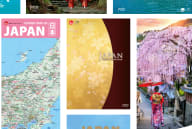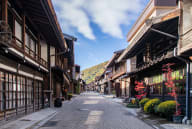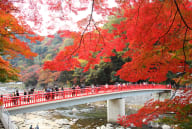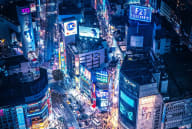An ancient pilgrimage route takes in Shinto shrines and millennia-old hot springs.
The moon's an egg, waxing toward full. It hangs over the mountain that looms over the Oto River. A toe in the water, steam rising off it, suggests I should go in gradually, for this is the Sennin Buro Bath, a spacious sectioned-off part of the river fed by hot springs. Sennin Buro means thousand-people bath, but this cool November night we seem to be more like 20 or 30.
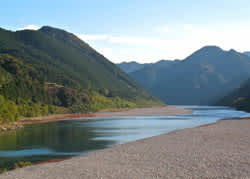
Feet in to the ankles — long pause — then I hunker down in the waist-deep water and feel my internal thermometer shoot volcanic. The trio of Japanese guys along the way don't seem to mind the heat, so I determine to tough it out. For two minutes.
Then, I take a breather, sitting on the rim of the bath. The trio follow my lead, and there we are ranged along the water, naked as jaybirds. That's when the women come in, across the steaming water from us, wearing their modesty robes. These are pale and short and, once wet, render them not naked but nude, every curve and crevice enunciated by the brilliant moonlight, as fleshy and phosphorescent as a group of Cézanne bathers.
HOT SPRINGS ETERNAL
I'm in Kawayu, a village on the Kii Peninsula in southern Honshu — four and a half hours from Kyoto, or a day's train ride and a distinct change of pace from Tokyo. It's not much more than a stretch of blacktop lined with inns and guesthouses overlooking the water. Do people up in their rooms watch us from their wide windows like we’re the best show in town? Or are we all just part of the riverscape, an every night occurrence, a hot springs where people have bathed naked for thousands of years?
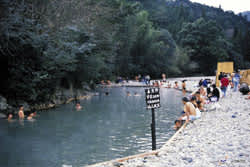
In trendier, more populous parts of Japan, onsen — which can mean either a single hot springs or a village or town dotted with them — can be fancy and pricey, with fabulously exclusive traditional wood, paper and thatch ryokan inns or multi-storied modern takes on the concept with guests arriving by the busload.
Omuraya Minshuku (a minshuku is an unpretentious guesthouse) keeps it simple and spare. My single room features the regulation tatami mats covering the floor, a thin futon, a thicker duvet, a TV, a kettle and a WC just big enough to hold a classic Toto digital toilet, complete with bidet and spray functions, and a pair of toilet slippers, which seem superfluous since by the time I've crowbarred my big feet into them it's time to leave.
Wash basins are found in a communal room down the hall, and the bath — well, the bath's the communal one in the river, although there are also two small private baths off the minshuku's narrow lobby. Dinner and breakfast are included in the price of the room and, apart from the public bath, are the best reasons for staying at Omuraya. A Japanese inn dinner, with its 20 or 30 flavours and nearly as many courses, may push you into culinary shock.
There are ribbon-thin beef slices cooked on your personal grill, a nice piece of sashimi or two, a grilled fish recently pulled from the river, fresh vegetables from sprouts to succulent mushrooms to sweet potatoes, a Japanese version of fried chicken, rice, a dab of potato salad, soup, shrimp, green onions, a variety of tiny pickles that crackle when you eat them — all accompanied by a king-size bottle of Sapporo. The other diners at the low tables scattered across the dining room include a Japanese tourist couple, a truck driver and bunch of construction workers.
THE WAY OF THE PILGRIM
Over the centuries the Kumano region ('kumano' means a deep and profound place) has been a land apart. Mountainous enough to keep everyone but the most intrepid voyagers out, rural enough to be self-sustaining, supplemented by fresh fish from rivers, streams and the Pacific Ocean. Locals sometimes call it paradise on earth.
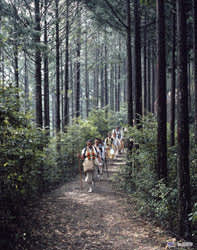
When people make the trek here it's usually to visit a triumvirate of Shinto shrines that create the spiritual triangle at Kumano's heart. For maybe as long as Japan has existed, Japanese pilgrims have ventured here to follow sacred pilgrimage routes — known as the Kumano Kodo — that lead from shrine to shrine.
Since 2004, this area has been a UNESCO World Heritage Site; the only other pilgrimage route to share this designation is the Way of St. James leading to Santiago de Compostela in Spain. Most tourists who come here — whether for spiritual or leisure reasons — are Japanese. In my three days in the area, I encountered one other Westerner.
Every Japanese knows what Shinto is. The rest of us have to guess at its meaning. It has no founder or first principles or all-powerful god; many Japanese don't even think of it as a religion; there are no commandments to speak of, or even fixed moral tenets. What it does have are lots of rituals, many as arcane as they are simple, often involving mirrors, water, salt, straw ropes, bells and sake.
There are also eight million kami in Shinto. ('Eight million' may be a mistranslation: the original Japanese word can also simply mean 'many'). Depending on whom you consult, these are either gods or spirits. Some represent phenomena (fertility's a popular one); others are for elements of nature, like rain, rivers, the persimmon tree in the backyard; yet others are animal manifestations (the fox, the snake); and still others represent one's ancestors.
Kami don't exist in a supernatural world — they're right here, hanging out with us in what we like to call the real world. They're not particularly authoritarian, some behave quite badly, and if you still don't get what a kami is, Shinto experts will shrug their shoulders and explain that human beings are simply incapable of understanding their nature.
This doesn't stop people trying, which perhaps accounts for Shinto's popularity within Japan, where there's always been a high tolerance for ambiguity, and for its failure to catch on anywhere else in the world. Certain places in Japan have a particularly high concentration of kami: these are called power spots. Pilgrims and mystics gravitate to these in order to absorb their mystical powers.
SHINTO DEEP, MOUNTAIN HIGH
On a warm fall morning, I begin my pilgrimage high up a mountainside at a torii (ceremonial gate) and a small vermilion shrine beyond it known as the "gate of awakening of the aspiration to enlightenment." It marks the outermost entrance into the divine precincts of the Shinto shrine I’m heading for: Kumano Hongu Taisha. From there the path winds through a forest of closely planted cedar and cypress, some relatively recent growth, many ancient, and out into mountainside small-hold farms and villages.
There are 3600 mountain peaks in the Kumano region, and at times during this walk I feel I'm seeing them all, layer after layer of mountains, like waves in a high inland sea. Kerchiefed women hoe in their gardens. Small unsupervised wooden stands offer local specialties like persimmons, salty pickled plums or honey fresh from the hive. These operate on the honour system — you drop your yen in the jar and take what you want. Open-sided teahouses give on to stunning views of field, forest and valleys. The trees of the upper reaches are already turning gold and crimson, deep in the valleys they still hold on to their green.
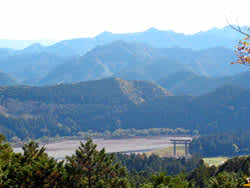
Kumano Hongu Taisha, the most sacred of the Kumano region's three great Shinto shrines, stands on a ridge overlooking the small town of Hongu and the Kumanogawa River that runs through it. The complex, which includes a wide gate and three kami-containing shrines, is relatively new, built in the late 19th-century after flooding destroyed the original site on the banks of the river. But the rough-hewn buildings have been constructed using traditional styles and techniques, including cypress bark wide-eaved roofs and elaborate joinery rather than screws and nails.
A Shinto priest, Mr. Hasegawa, resplendent in white linen robes, meets me in the shrine's central courtyard and points out that the complex contains shrines devoted to specific Shinto kami but, confusingly, these kami are also thought to be manifestations Buddhas. This blending of the two religions isn't unusual in Japan. In fact it's hard to find a Shinto shrine without a Buddhist temple nearby and vice versa.
If this all seems impenetrable then you're probably on the right track for understanding Shintoism, more a communal way of living than a religion, and something the Japanese didn't even bother naming until Buddhism came along and they felt they had to distinguish their native form of worship.
None of these fine distinctions seem to matter much as I stand with Mr. Hasegawa in the courtyard. The sun's warm, great crows caw and flap their wings in the ancient trees that surround the shrine. Could this be considered a hot spot? "Pilgrims," he comments with great certainty, "don't come to Kumano Hongu Taisha, they are called here."
This seems strangely plausible, in this heart of the heart of sacred Kumano.
About the writer
Will Aitken is a Montreal-based travel and arts journalist. His work has appeared in enRoute, Globe & Mail, Elle Canada, National Post, Maclean's and a variety of other publications. He also has worked as a writer-broadcaster for the CBC, TVOntario, the BBC and NPR and has published three novels: Realia, A Visit Home and Terre Haute. His book about Italian filmmaker Luchino Visconti - A Candle to My Shames: The Venetian Films of Luchino Visconti - was published in 2011. He has also taught multimedia production, film studies, English literature and classics at Concordia University, McGill University and Dawson College and has been a guest curator at Harvard University's Film Archives.
The opinions expressed in the above article do not reflect the views of JNTO. All content and images are property of the writer unless otherwise specified.
*This article is based on the writer's experience before COVID-19.


















































